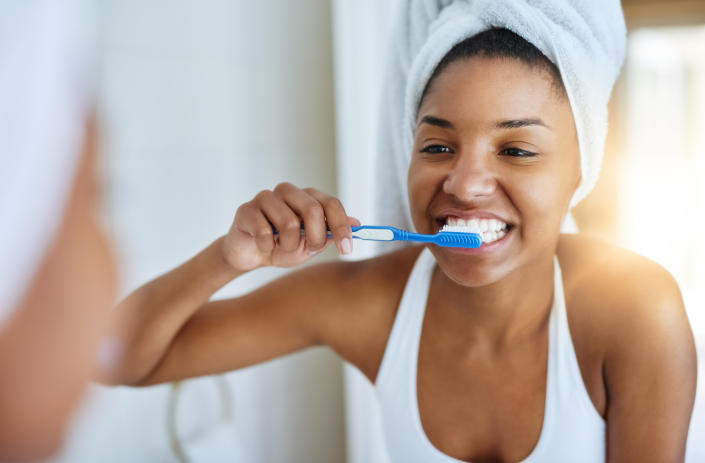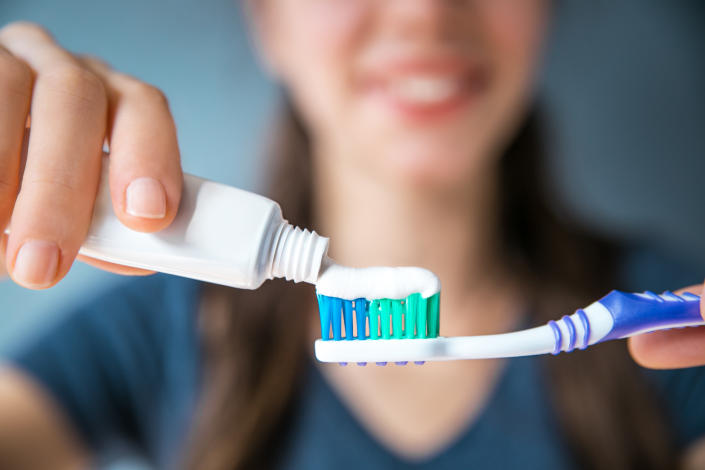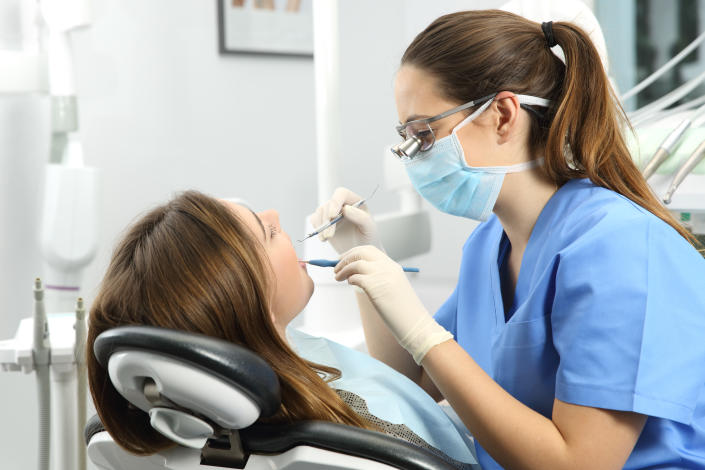Brushing our teeth twice a day is a task many of us have been doing for as long as we can remember.
Most people know that skipping this daily routine could result in cavities, dirty teeth and oral health issues.
What’s important to keep in mind is that this daily ritual has a much bigger impact than just on someone’s oral health — it affects a person’s overall health, too.
Whether it’s the toothbrush being used, a person’s brushing technique or forgetting to floss, it all makes a difference to oral hygiene.
Donna Wells, an Ottawa-based dental hygienist, says there are seven common mistakes people make when it comes to oral health. She explains to Yahoo Canada how people can avoid health issues that could arise from making these mistakes.
1. Brushing too hard
People who brush their teeth too hard are called “scrubbers,” and Wells says it’s the most common mistake she sees.
Brushing too aggressively can lead to gum recession, and that can turn into worse problems.
“When you have gum recession, that causes bone loss, and bone loss leads to tooth loss,” Wells, who is also the manager of professional practice at the Canadian Dental Hygienist Association, adds.
So next time you’re brushing your teeth, remember — don’t be a scrubber!

2. Incorrect brushing technique
It’s not just brushing with force that can damage the inside of your mouth. Improper technique can also mean someone’s not cleaning your teeth effectively.
Wells says people should place their toothbrush at a 45-degree angle, and half the bristles should be on their gums.
“You do want to brush the gums and massage them. It removes bacteria from underneath the gum line,” she explains. “Then, you’re just rolling away from the gums.”
She adds that this is the “most effective and gentle way to brush.”
Dental Hygiene Canada provides a full breakdown of toothbrushing basics, including every part of a person’s mouth that needs to be targeted with their brush.
3. Using the wrong toothbrush
Another common mistake is using a toothbrush with medium or hard bristles, which Wells says can be too tough for your gums and can once again lead to gum recession.
Instead, she recommends a toothbrush with soft or extra soft bristles.
If someone’s questioning whether to choose an electric toothbrush or a regular toothbrush — that’s up to personal preference. However, an electric toothbrush is more effective in removing plaque.
“When you’re using an electric toothbrush, it’s important to let the brush do all the work for you,” Wells says. “You place the brush, half on the gums, half on the teeth, and then you’re just moving it nice and slowly across the gums. There’s no actual brushing moment motion.”
Size also matters when it comes to choosing the right toothbrush. People should ensure they choose a toothbrush based on the size of their mouth. For example, if someone has a small mouth, they should get a brush with a smaller head, or a children’s toothbrush.
The American Dental Association also advises that people replace their toothbrush every three to four months, or sooner if the bristles are matted or frayed.

4. Not brushing twice a day or long enough
Don’t rush while brushing!
People should make sure they leave enough time in the morning and before bedtime to brush their teeth for at least two minutes each time.
Wells says as soon as a person brushes their teeth, plaque and bacteria start to form again. The longer it’s left to continue to grow, “the stickier it becomes and it gets harder to remove.”
Before finishing brushing, people should remember to clean their tongue, since it’s also an area prone to bacteria. Wells says using a tongue scraper is possible, but a toothbrush works just as well.
5. Not choosing the right toothpaste
Choosing the right toothpaste is based on individual needs.
People with sensitive teeth will likely want a toothpaste designed for sensitivity; those who are more prone to gingivitis — which is the inflammation of the gums — might choose a toothpaste that targets that gum disease.
“If somebody has a is a higher risk for cavities, then there are certain toothpastes that have a higher amount of fluoride in them that will help kind of harden that tooth structure and prevent cavities from happening,” Wells says.
Anyone who’s unsure which toothpaste to choose should consider the Canadian Dental Association’s list of specific products that provide oral health benefits.
As for finishing off with mouthwash, Wells says it’s not necessary, but there’s no harm in using it. If someone struggles with bad breath or cavities, then they may want to give the antibacterial rinse a try.

6. Not cleaning in between the teeth at least once a day
If a person tends to skip out on flossing, they may want to rethink that next time they get ready to brush their teeth.
Wells advises that everyone should floss or use a dental tool to remove bacteria in between the teeth at least once a day.
“Although floss is considered the gold standard, using tools like a Waterpik, or interdental cleaners such as Soft-Picks or Proxabrushes are also effective at minimizing bacteria growth in between the teeth and under the gum line, and for a lot of people, easier to use,” she adds.
7. Not going for regular dental check-ups
A big mistake people make when it comes to their oral health is not going for regular dental appointments.
Wells advises going at least twice a year for a check-up and cleaning. She says a dental hygienist will provide an assessment of the health of a person’s mouth, provide guidance on areas they can improve on and will let them know what tools will work best.
If someone can’t go see a dental hygienist due to mobility or other issues, a dental hygienist can often make a house call. Many professionals work independently and can make visits to homes and long-term care facilities. On its website, Dental Hygiene Canada can help people find a dental hygienist near their home.

Oral health impacts your overall health
Avoiding these seven common mistakes will not only benefit a person’s oral health but their overall health, too.
The Canadian Dental Association (CDA) notes the mouth is the gateway to the body and an unhealthy build-up in the mouth can increase someone’s risk of other health problems.
Bacteria build-up can make gums prone to infection and lead to periodontal (gum) disease, which is an infection of the tissues that hold teeth in place.
Gum disease is typically caused by things like not brushing twice a day, not flossing and not going for regular dental cleanings.
Poor oral hygiene can also lead to other health conditions like cardiovascular disease, respiratory disease and diabetes.
The CDA says good oral health can be maintained by knowing about the different risk factors, which include an unhealthy diet high in sugar, smoking, drinking and poor oral hygiene.
****
This article is for informational purposes only and is not a substitute for professional medical advice, diagnosis or treatment. Contact a qualified medical professional before engaging in any physical activity, or making any changes to your diet, medication or lifestyle.

